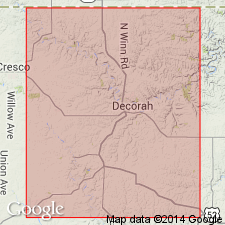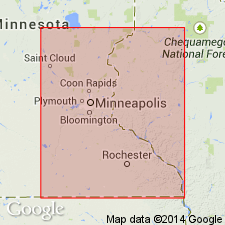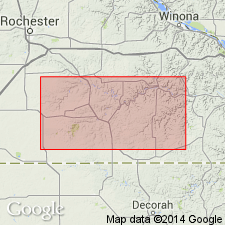
- Usage in publication:
-
- Ion member
- Modifications:
-
- Original reference
- Dominant lithology:
-
- Shale
- Limestone
- AAPG geologic province:
-
- Iowa shelf
Summary:
Pg. 16. Ion member of Decorah formation. Calcareous shale and argillaceous limestones, the limestones irregularly dolomitized in southeastern part of their outcrop in Iowa. The beds become more argillaceous to north and more calcareous to southeast. Thickness 16 feet. Top member of Decorah formation. Rests on Guttenberg limestone member. Fossils are of basal Trenton (Rockland) age [Middle Ordovician]. [See also Kay, 1929 (Jour. Geol., v. 37, no. 7, Oct.-Nov., p. 639-671), who stated this member corresponds fo Fucoid bed and CHASMATOPORA bed of Minnesota.]
Type locality: in ravine along road, in NW/4 sec. 35, T. 96 N., R. 4 W., about 1 mi southwest of hamlet of Ion, [Giard 7.5-min quadrangle], Allamakee Co., northeastern IA.
Source: US geologic names lexicons (USGS Bull. 896, p. 1018; USGS Bull. 1200, p. 1875).

- Usage in publication:
-
- Ion member
- Modifications:
-
- Areal extent
- AAPG geologic province:
-
- Iowa shelf
Summary:
Pg. 295. Showed his Ion, Guttenberg, and Spechts Ferry members as present in Minnesota and northwestern Illinois. [Age is Middle Ordovician (Trenton).]
[Recognized in northeastern IA, northwestern IL, southeastern MN, and southwestern WI.]
Source: US geologic names lexicons (USGS Bull. 896, p. 1018).

- Usage in publication:
-
- Ion submember
- Modifications:
-
- Revised
- AAPG geologic province:
-
- Sioux uplift
Summary:
p. 9 (geol. column), 81, 83-85. Ion considered submember of Decorah shale member of Galena formation in Minnesota. Occurs at top of Decorah; overlies Guttenberg submember. Consists of calcareous shale with layers or lenses of argillaceous limestone. Thickness 15 to 20 feet in St. Paul area, southeastern Minnesota. [Age is Middle Ordovician.]
Source: US geologic names lexicon (USGS Bull. 1200, p. 1875).

- Usage in publication:
-
- Ion member
- Modifications:
-
- Areal extent
- AAPG geologic province:
-
- Iowa shelf
Summary:
Pg. 763. Ion member of Decorah formation. Members of Decorah formation (Spechts Ferry, Guttenberg, and Ion) not recognizable rock units in Minnesota.
Source: US geologic names lexicon (USGS Bull. 1200, p. 1875).
For more information, please contact Nancy Stamm, Geologic Names Committee Secretary.
Asterisk (*) indicates published by U.S. Geological Survey authors.
"No current usage" (†) implies that a name has been abandoned or has fallen into disuse. Former usage and, if known, replacement name given in parentheses ( ).
Slash (/) indicates name conflicts with nomenclatural guidelines (CSN, 1933; ACSN, 1961, 1970; NACSN, 1983, 2005, 2021). May be explained within brackets ([ ]).

